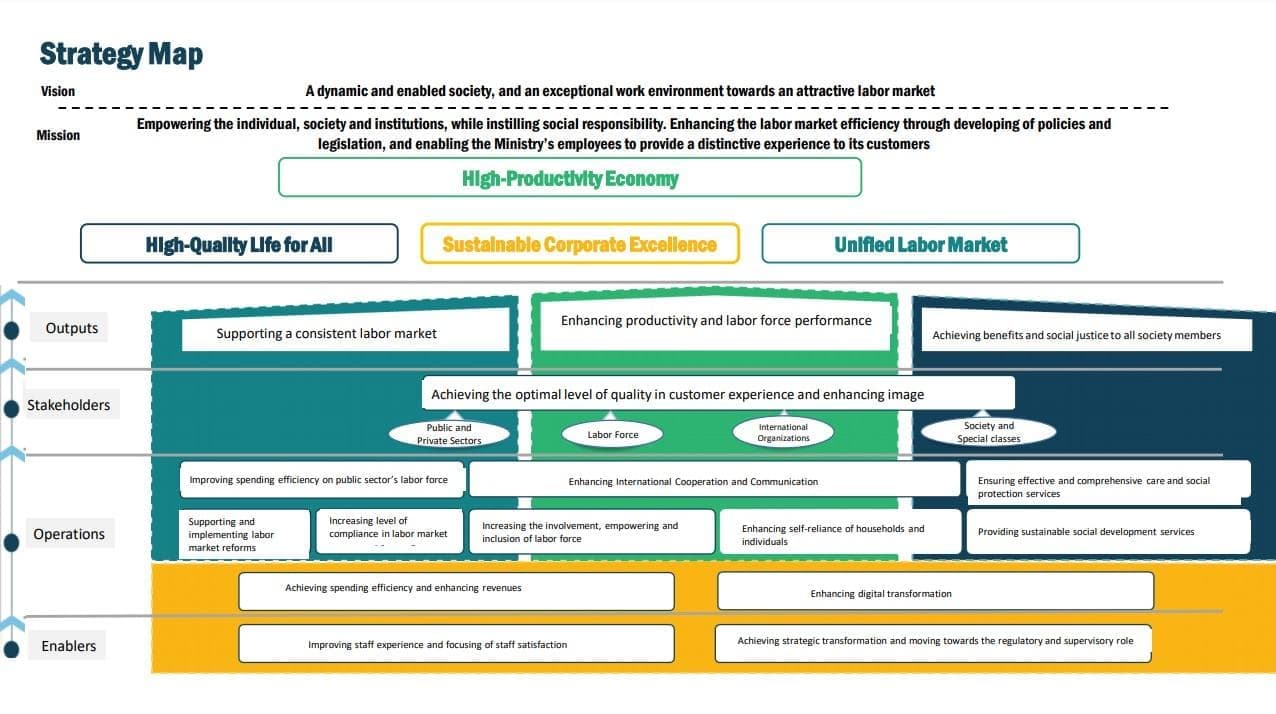Ministry strategy
MHRSD gets unlimited support by the wise leadership due to its extended scopes of supervision, areas of work and its significant role in achieving targets of the national transformation and objectives of the Kingdom's Vision 2030. Today, MHRSD has a number of strategic objectives that aim to raise efficiency, effectiveness and attractiveness of the Saudi labor market, enhance safety and social protection net, increase non-profit sector's contribution to the national economy, achieve sustainable social development, raise the level of public sector's productivity, develop its systems and increase their flexibility to enhance its role in supporting GDP.
Since the Royal Order No. (A/455) dated Ragab 1st, 1441 AH has been issued that provides for consolidating the Ministry of Social Service with the Ministry of Labor and Social Development and modifying its name to be the "Ministry of Human Resources and Social Development", MHRSD achieves remarkable results that suit objectives of such decision, as the decision of consolidating the two ministries was a successful step that resulted in commendable results by increasing coordination and integration between the sectors, contributing to creating job opportunities for men and women jobseekers in this dear country, achieving the State's aspiration of investment in the human capital and achieving targets of sustainable local development.
In addition, MHRSD has worked on developing and adopting its strategy in May 2020 according to the best practices adopted in the strategic planning with the aim of providing a comprehensive and integrated roadmap to achieve its vision derived from the Kingdom’s Vision 2030, which was developed in alignment with the sectoral strategies that MHRSD supervises their implementation.
MHRSD Strategy includes its four sectors (labor sector, social development, civil service and shared services). In addition, MHRSD vision and mission was drawn to show the ambition and services provided to all beneficiaries in public, private and non-profit sector as a legislative and supervisory entity in the first place, then a service and supporting entity by working with the individuals and related parties to improve and transform the work environment into an attractive and high-quality standards environment, in addition to raising the portion of Saudi men and women in labor market and empowering women through initiatives, projects and programs that contribute to raising efficiency and productivity of the economy, sustainable development and decent living for all through sustainable corporate excellence.
Vision
A dynamic and enabled society, and an exceptional work environment towards an attractive labor market.
Mission
Empowering the individual, society, and institution, while instilling social responsibility. Enhancing the labor market efficiency through developing policies and legislation, and enabling the ministry employees to provide a distinctive experience to its customers.
Strategy Map

Ministry values
- Focus on customers
- Social responsibility
- Participation
- Cooperation
- Excellence
- Support a harmonious labor market.
- Improve productivity and performance of manpower.
- Achieve benefit and social justice for all society members.
- Achieve the optimal level of customer experience and enhance the mental image.
- Raise the efficiency of spending on public-sector manpower.
- Enhance international cooperation and communication.
- Ensure effective and comprehensive social care and protection services.
- Support and apply labor market reforms.
- Raise the level of compliance in the labor market.
- Increase participation, empowerment, and comprehensiveness of manpower.
- Strengthen the self-reliance of families and individuals.
- Provide sustainable social development services.
- Achieve spending efficiency and enhance revenues.
- Enhance digital transformation.
- Improve employee experience and focus on customer satisfaction.
- Achieve strategic transformation and transition to the organizational and supervisory role.
- Encouraging telework.
- Improving the contractual relationship between the employee and employer.
- Stimulating employers to develop environments suitable for people with disabilities (PWDs).
- Labor Education Program.
- Encouraging flexible work.
- Training that is parallel to the labor market's requirements.
- Providing child care services for working women (Qurrah).
- Building voluntary work culture and incentives.
- Rehabilitating manpower and providing job opportunities in the non-profit sector.